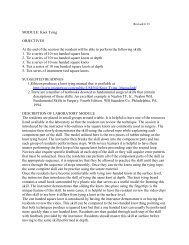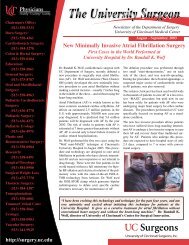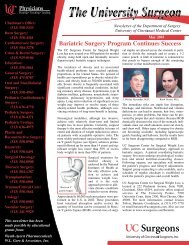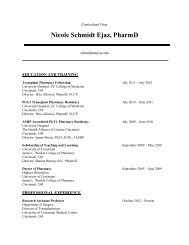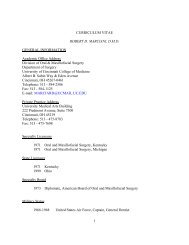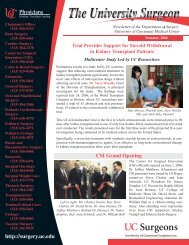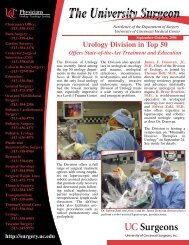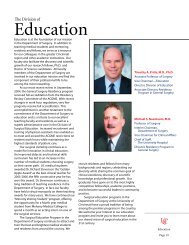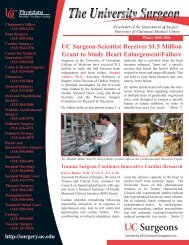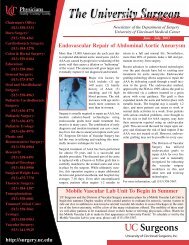History of the Department - Surgery - University of Cincinnati
History of the Department - Surgery - University of Cincinnati
History of the Department - Surgery - University of Cincinnati
You also want an ePaper? Increase the reach of your titles
YUMPU automatically turns print PDFs into web optimized ePapers that Google loves.
George J. Heuer, 1922-1931<br />
Mont R. Reid, 1931-1943<br />
Max Zinninger, 1943-1946<br />
B. Noland Carter, 1946-1953<br />
<strong>History</strong> <strong>of</strong> <strong>the</strong> <strong>Department</strong><br />
The UC <strong>Department</strong> <strong>of</strong> <strong>Surgery</strong> was derived from pioneering American surgeons and <strong>the</strong><br />
evolution <strong>of</strong> local colleges <strong>of</strong> medicine and hospitals that parallel <strong>the</strong> origins and growth <strong>of</strong><br />
<strong>Cincinnati</strong> itself, dating as far back as 1788. The "Hopkins Invasion" <strong>of</strong> 1922 marks <strong>the</strong> birth <strong>of</strong> <strong>the</strong><br />
contemporary <strong>Department</strong> <strong>of</strong> <strong>Surgery</strong> at <strong>the</strong> <strong>University</strong> <strong>of</strong> <strong>Cincinnati</strong>. Dr. George Heuer and a<br />
small group <strong>of</strong> surgeons from Dr.William Halsted’s department at Johns Hopkins Medical School<br />
moved from Baltimore to <strong>Cincinnati</strong> and established a full-time surgical department with a<br />
pyramid-structured general surgery residency training program to graduate highly qualified<br />
surgeons after several years <strong>of</strong> rigorous training. After <strong>the</strong> Peter Bent Brigham Hospital at<br />
Harvard Medical School in Boston, <strong>the</strong> UC <strong>Department</strong> <strong>of</strong> <strong>Surgery</strong> was <strong>the</strong> second program in<br />
<strong>the</strong> country to be patterned on <strong>the</strong> Hopkins model.<br />
Dr. George Heuer, <strong>the</strong> first Christian R. Holmes Pr<strong>of</strong>essor <strong>of</strong> <strong>Surgery</strong>, brought Dr. Halsted’s<br />
method <strong>of</strong> surgical training to <strong>Cincinnati</strong>, along with several <strong>of</strong> Halsted’s residents including<br />
future department chairmen, Mont Reid, B. Noland Carter and Max Zinninger. He established <strong>the</strong><br />
now routine practice <strong>of</strong> taking thorough case histories <strong>of</strong> patients and regular follow-up care.<br />
He instituted that all tissue be studied in <strong>the</strong> lab to confirm a surgeon’s diagnosis, again a now<br />
routine practice. The tradition <strong>of</strong> superior quality and surgical innovation continued under<br />
subsequent chairs <strong>of</strong> <strong>the</strong> <strong>Department</strong>.<br />
Dr. Mont Rogers Reid (1931-1943) worked tirelessly to streng<strong>the</strong>n <strong>the</strong> relationship between <strong>the</strong><br />
university medical school and <strong>the</strong> community. He brought attention to <strong>the</strong> <strong>Department</strong> through<br />
numerous articles in <strong>the</strong> prestigious New England Journal <strong>of</strong> Medicine on wound healing processes.<br />
Dr. Max Zinninger (1943-1946) led <strong>the</strong> <strong>Department</strong> in <strong>the</strong> interim years after Dr. Reid’s<br />
untimely death. He was one <strong>of</strong> <strong>the</strong> first to complete his surgical residency at UC in 1927 under<br />
Heuer. Also known for working collaboratively with community physicians on complicated<br />
cases requiring highly specialized care, he was considered a consummate surgeon and gentleman<br />
who was held in <strong>the</strong> highest regard by <strong>the</strong> community, his students and colleagues.<br />
Dr. B. Noland Carter (1946-1952), <strong>the</strong> third Christian R. Holmes Pr<strong>of</strong>essor <strong>of</strong> <strong>Surgery</strong>, was<br />
recognized nationally for his research <strong>of</strong> tissue injury and burns. He developed partnerships<br />
with <strong>the</strong> military and industry investigating newer antibiotics. During Carter’s tenure, <strong>the</strong><br />
isotope laboratory was formed to study and treat neoplasm. Dr. Charles Barrett, forefa<strong>the</strong>r <strong>of</strong> <strong>the</strong><br />
Barrett Cancer Center, was recruited to lead this effort. Radioisotope and tracer studies for<br />
diagnosis were pioneered here. A vascular lab was established and <strong>the</strong> <strong>Department</strong> made great<br />
progress in cardiothoracic surgery including cardioangiography and <strong>the</strong> first perfusion carried<br />
out. Investigations were also established for lung cancer. In <strong>the</strong> early 1950’s, UC <strong>Department</strong> <strong>of</strong><br />
<strong>Surgery</strong> was well established as one <strong>of</strong> <strong>the</strong> premier centers for study <strong>of</strong> coronary circulation and<br />
artificial circulation. One <strong>of</strong> <strong>the</strong> most notable achievements came in 1951, when Dr. James<br />
Helmsworth <strong>of</strong> <strong>the</strong> UC <strong>Department</strong> <strong>of</strong> <strong>Surgery</strong> joined cardiologist Dr. Samuel Kaplan and<br />
chemist Dr. Leland Clark to develop <strong>the</strong> world's first functional heart-lung machine, located at<br />
<strong>Cincinnati</strong> Children's Hospital Medical Center.<br />
<strong>History</strong> <strong>of</strong> <strong>the</strong> <strong>Department</strong> | Page 10
Dr. William Altemeier (1952-1978), <strong>the</strong> fourth Christian R. Holmes Pr<strong>of</strong>essor <strong>of</strong> <strong>Surgery</strong>,<br />
fur<strong>the</strong>r expanded <strong>the</strong> <strong>Department</strong> with a focus on microbiology and intra-abdominal infections,<br />
establishing <strong>the</strong> <strong>Department</strong> as a pioneering center for surgical infectious disease. The perineal<br />
repair for rectal prolapse is named for Dr. Altemeier. Dr. Altemeier was <strong>the</strong> first to describe<br />
cancer <strong>of</strong> <strong>the</strong> proximal (hilar) bile ducts, an entity subsequently recognized and named after<br />
Klatskin. Dr. Altemeier oversaw <strong>the</strong> building <strong>of</strong> <strong>the</strong> first surgical research facility in <strong>the</strong> mid 50’s.<br />
The Shriners Burns Hospital, one <strong>of</strong> three in <strong>the</strong> nation, was built in <strong>Cincinnati</strong> due to <strong>the</strong> strong<br />
advocacy <strong>of</strong> Drs. William Altemeier, Robert Hummel, and Bruce MacMillan in <strong>the</strong> treatment <strong>of</strong><br />
burn injuries. A strong connection made between <strong>Cincinnati</strong> and <strong>the</strong> US Army Burn Center in<br />
San Antonio, Texas, still exists today. The pediatric surgery residency training program was<br />
founded at Children’s Hospital in <strong>the</strong> late 1950’s by Dr. Lester Martin, who raised pediatric surgery<br />
to new levels and trained numerous pediatric surgeons who have become leaders in <strong>the</strong> field,<br />
including Dr. Brad Warner. Dr. Martin also pioneered and perfected <strong>the</strong> surgical technique<br />
known as <strong>the</strong> "pull-through" procedure for ulcerative colitis. Significant developments in thyroid<br />
surgery and hand surgery were pioneered by Dr. Vinton "Hoppy" Siler, who was also a great<br />
benefactor <strong>of</strong> <strong>the</strong> <strong>Department</strong>. In <strong>the</strong> mid 1960s, Dr. J. Wesley Alexander led UC’s transplant and<br />
immunology program, training many transplant fellows and conducting significant research<br />
funded for decades by <strong>the</strong> National Institutes <strong>of</strong> Health. Dr. Henry Neale, a UC medical school<br />
graduate, returned to <strong>Cincinnati</strong> in 1974, following a fellowship at Duke <strong>University</strong>, and founded<br />
<strong>the</strong> plastic surgery residency program. This program has attracted and graduated plastic<br />
surgeons who are considered among <strong>the</strong> very best in <strong>the</strong> country. Dr. Neale turned over <strong>the</strong><br />
helm <strong>of</strong> <strong>the</strong> division <strong>of</strong> plastic surgery in 2004 to Dr. John Kitzmiller, one <strong>of</strong> his former plastic<br />
surgery residents.<br />
Dr. Josef Fischer (1978-2001), <strong>the</strong> fifth Christian R. Holmes Pr<strong>of</strong>essor <strong>of</strong> <strong>Surgery</strong>, was responsible<br />
for significant expansion <strong>of</strong> full-time faculty in <strong>the</strong> early 1980’s, initiating or streng<strong>the</strong>ning<br />
subspecialty areas including vascular, trauma and critical care, transplant, burn, plastic surgery<br />
and urology. Dr. Fischer was instrumental in transforming <strong>the</strong> former <strong>Cincinnati</strong> General Hospital<br />
from a city-county hospital into The <strong>University</strong> Hospital, a tertiary medical center and <strong>the</strong><br />
flagship <strong>of</strong> The Health Alliance. The urology residency program again had its center at <strong>the</strong><br />
<strong>University</strong> <strong>of</strong> <strong>Cincinnati</strong> Medical Center and has since enjoyed great success and growth, as has<br />
<strong>the</strong> oral and maxill<strong>of</strong>acial surgery residency program. Physical growth was also seen with <strong>the</strong><br />
building <strong>of</strong> <strong>the</strong> Barrett Cancer Center, a critical care tower and new operating rooms.<br />
The growing transformation and expansion <strong>of</strong> <strong>the</strong> <strong>Department</strong> continued under <strong>the</strong><br />
leadership <strong>of</strong> Dr. Jeffrey Mat<strong>the</strong>ws (2001-2006), who led <strong>the</strong> <strong>Department</strong> into <strong>the</strong> exciting future<br />
<strong>of</strong> robotic surgery, genomic science, telemedicine and surgical training available to<br />
medical students, residents, faculty and community surgeons alike. The emphasis placed by<br />
Dr. Mat<strong>the</strong>ws on multidisciplinary treatment centers has led to great innovations in <strong>the</strong><br />
treatment <strong>of</strong> liver and pancreas disease, cardiac disease, morbid obesity and a variety <strong>of</strong><br />
gastrointestinal disorders. Patients now come to <strong>the</strong> <strong>University</strong> <strong>of</strong> <strong>Cincinnati</strong> from all 50 states<br />
for <strong>the</strong>ir special healthcare needs. At <strong>the</strong> same time, Dr. Mat<strong>the</strong>ws ushered in a new era <strong>of</strong><br />
partnership between UC Surgeons and <strong>the</strong> Greater <strong>Cincinnati</strong> Community.<br />
Michael S. Nussbaum, MD, Pr<strong>of</strong>essor <strong>of</strong> <strong>Surgery</strong>, has been named interim chair <strong>of</strong> <strong>the</strong><br />
<strong>Department</strong> <strong>of</strong> <strong>Surgery</strong> while a national search is conducted to determine a permanent replacement<br />
for Dr. Mat<strong>the</strong>ws, who has become chair <strong>of</strong> <strong>the</strong> department <strong>of</strong> surgery at <strong>the</strong> <strong>University</strong> <strong>of</strong><br />
Chicago. Dr. Nussbaum is Chief <strong>of</strong> Staff at The <strong>University</strong> Hospital and has served as Vice Chair<br />
for Clinical Affairs in <strong>the</strong> <strong>Department</strong> <strong>of</strong> <strong>Surgery</strong> since 2003. He has been a member <strong>of</strong> <strong>the</strong> UC<br />
faculty since 1986. His clinical and research interests are in gastrointestinal surgery. In particular,<br />
Dr. Nussbaum is involved in outcomes-related studies involving videoscopic surgery, clinical<br />
pathway development, surgery for inflammatory bowel disease, and <strong>the</strong> surgical treatment <strong>of</strong><br />
swallowing disorders. Dr. Nussbaum just completed a six-year appointment as a Director <strong>of</strong> <strong>the</strong><br />
American Board <strong>of</strong> <strong>Surgery</strong> and a four-year appointment as a Director <strong>of</strong> <strong>the</strong> American Board <strong>of</strong><br />
Emergency Medicine. His longstanding commitment to excellence in patient care will help to<br />
advance <strong>the</strong> <strong>Department</strong>’s mission <strong>of</strong> fostering education, research, and innovations for treating<br />
surgical patients.<br />
<strong>History</strong> <strong>of</strong> <strong>the</strong> <strong>Department</strong> | Page 11<br />
William A. Altemeier, 1952-1978<br />
Josef E. Fischer, 1978-2001<br />
Jeffrey B. Mat<strong>the</strong>ws, 2001-2006<br />
Michael S. Nussbaum, As <strong>of</strong> September 1, 2006



